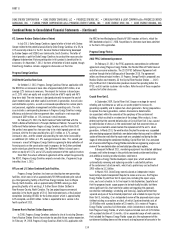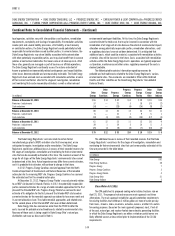Duke Energy 2012 Annual Report Download - page 161
Download and view the complete annual report
Please find page 161 of the 2012 Duke Energy annual report below. You can navigate through the pages in the report by either clicking on the pages listed below, or by using the keyword search tool below to find specific information within the annual report.
141
PART II
Combined Notes to Consolidated Financial Statements – (Continued)
DUKE ENERGY CORPORATION • DUKE ENERGY CAROLINAS, LLC • PROGRESS ENERGY, INC. • CAROLINA POWER & LIGHT COMPANY d/b/a PROGRESS ENERGY
CAROLINAS, INC. • FLORIDA POWER CORPORATION d/b/a PROGRESS ENERY FLORIDA, INC. • DUKE ENERGY OHIO, INC. • DUKE ENERGY INDIANA, INC.
discussed above. On December 29, 2012, the Indiana Court of Appeals upheld
the IURC’s decision to deny recovery of the storm costs.
Phase 2 Environmental Compliance Proceeding.
On June 28, 2012, Duke Energy Indiana fi led with the IURC a plan for
the addition of certain environmental pollution control projects on several of
its coal-fi red generating units in order to comply with existing and proposed
environmental rules and regulations. The plan calls for a combination of
selective catalytic reduction systems, dry sorbent injection systems for SO3
mitigation, activated carbon injection systems and/or mercury re-emission
chemical injection systems. The capital costs are estimated at $395 million
(excluding AFUDC). Duke Energy Indiana also indicated that it preliminarily
anticipates the retirement of Wabash River Units 2 through 5 in 2015 and is still
evaluating future equipment additions or retirement of Wabash River Unit 6. An
evidentiary hearing was held January 7, 2013 through January 9, 2013, with an
order expected in the second quarter of 2013.
Other Regulatory Matters
Progress Energy Merger NCUC Investigation.
On July 6, 2012, the NCUC issued an order initiating investigation and
scheduling hearings addressing the timing of the Duke Energy Board of Directors’
decision on July 2, 2012, to replace William D. Johnson with James E. Rogers
as President and Chief Executive Offi cer (CEO) of Duke Energy, as well as other
related matters.
Pursuant to the merger agreement, William D. Johnson, Chairman,
President and CEO of Progress Energy became President and CEO of Duke
Energy and James E. Rogers, Chairman, President and CEO of Duke Energy
became Executive Chairman of Duke Energy upon close of the merger.
Mr. Johnson subsequently resigned as the President and CEO of Duke Energy,
effective July 3, 2012 and Mr. Rogers was appointed to be CEO.
On November 29, 2012, Duke Energy reached a settlement agreement
with the NCUC and the North Carolina Public Staff regarding the investigations
discussed above. Pursuant to the settlement agreement, Duke Energy agreed
to a number of terms, the most notable of which are (i) Duke Energy will
maintain at least 1,000 employees in Raleigh, North Carolina for at least fi ve
years from date of the settlement agreement; (ii) Duke Energy will guarantee an
additional $25 million in fuel and fuel-related cost savings for Duke Energy’s
North Carolina retail customers; (iii) Duke Energy will contribute an additional
$5 million to workforce development and low-income assistance in North
Carolina; (iv) Duke Energy Carolinas will defer fi ling a general rate case in North
Carolina until February 2013; and (v) Duke Energy will make various changes
in management and Board members, which includes CEO James E. Rogers
retirement no later than December 31, 2013. On December 3, 2012, the NCUC
approved the settlement agreement between Duke Energy, the NCUC and the
North Carolina Public Staff. The settlement agreement resolves all matters
related to the NCUC investigation.
Duke Energy has also been contacted by the SEC to explain the
circumstances surrounding the NCUC Investigation and shareholder lawsuits
in connection with the closing of the merger with Progress Energy. See Note 5 for a
discussion of shareholder litigation. A meeting was held with the SEC staff in late
October. Duke Energy intends to continue to assist the SEC staff, as they request.
Progress Energy Merger North Carolina Department of Justice
(NCDOJ) Investigations. Duke Energy also received an Investigative Demand
issued by the NCDOJ on July 6, 2012, requesting the production of certain
documents related to the issues which were also the subject of the NCUC
Investigation discussed above. Duke Energy’s responses to these requests were
submitted on August 7, 2012. On August 1, 2012, the NCUC engaged the law fi rm
of Jenner & Block to conduct an investigation of these matters. On December 3,
2012, Duke Energy reached a settlement agreement with the NCDOJ.
Joint Dispatch Agreement (JDA). On June 29, 2012, and July 2, 2012,
the NCUC and the PSCSC, respectively, approved the JDA between Duke Energy
Carolinas and Progress Energy Carolinas. The JDA provides for joint dispatch
of the generating facilities of both Duke Energy Carolinas and Progress Energy
Carolinas for the purpose of reducing the cost of serving the native loads of
both companies. As set forth in the JDA, Duke Energy Carolinas will act as the
joint dispatcher, on behalf of both Duke Energy Carolinas and Progress Energy
Carolinas. As joint dispatcher, Duke Energy Carolinas will direct the dispatch
of both Duke Energy Carolinas’ and Progress Energy Carolinas’ power supply
resources, determine payments between the parties for the purchase and sale
of energy between Duke Energy Carolinas and Progress Energy Carolinas, and
calculate and allocate the fuel cost savings to the parties. The JDA is subject to
review by the PSCSC after one year. Refer to Note 14 for further discussion.
Planned and Potential Coal Plant Retirements. The Subsidiary
Registrants periodically fi le Integrated Resource Plans (IRP) with their state
regulatory commissions. The IRPs provide a view of forecasted energy needs
over a long term (15-20 years), and options being considered to meet those
needs. The IRP’s fi led by the Subsidiary Registrants in 2012 and 2011 included
planning assumptions to potentially retire by 2015, certain coal-fi red generating
facilities in North Carolina, South Carolina, Indiana and Ohio that do not have
the requisite emission control equipment, primarily to meet Environmental
Protection Agency (EPA) regulations that are not yet effective. Additionally,
management is considering the impact pending environmental regulations might
have on certain coal-fi red generating facilities in Florida.
The table below contains the net carrying value of generating facilities
planned for early retirement or being evaluated for potential retirement included
in Property, plant and equipment, net on the Consolidated Balance Sheets. In
addition to the amounts presented below, Progress Energy Carolinas and Duke
Energy Indiana have $128 million and $61 million, respectively, of net carrying
value related to previously retired generation facilities included in Regulatory
assets on their Consolidated Balance Sheets.
December 31, 2012
(in millions)
Duke
Energy
Duke Energy
Carolinas(b)(e)
Progress
Energy
Carolinas(c)(e)
Progress
Energy
Florida(d)
Duke
Energy
Ohio(f)
Duke
Energy
Indiana(g)
Capacity (in MW) 3,954 910 575 873 928 668
Remaining net
book value
(in millions)(a) $ 428 $106 $ 63 $115 $ 12 $132
(a) Included in Property, plant and equipment, net as of December 31, 2012, on the Consolidated Balance
Sheets, unless otherwise noted.
(b) Includes Riverbend Units 4 through 7, Lee Units 1 and 2 and Buck Units 5 and 6. Duke Energy Carolinas
has committed to retire 1,667 MW in conjunction with a Cliffside air permit settlement, of which 587 MW
have already been retired as of December 31, 2012. Duke Energy Carolinas plans to retire 710 MW for the
Riverbend Units 4 though 7 and Buck Units 5 and 6 effective April 1, 2013. Excludes 170 MW Lee Unit 3
that is expected to be converted to gas in 2014. The Lee Unit 3 conversion will be considered a retirement
toward meeting the 1,667 MW retirement commitment.
(c) Includes Sutton Station, which is expected to be retired by the end of 2013.
(d) Includes Crystal River Units 1 and 2.
(e) Net book value of Duke Energy Carolinas’ Buck Units 5 and 6 of $73 million, and Progress Energy
Carolinas’ Sutton Station of $63 million is included in Generation facilities to be retired, net, on the
Consolidated Balance Sheets at December 31, 2012.
(f) Includes Beckjord Station Units 2 through 6 and Miami Fort Unit 6. Beckjord has no remaining book value.
Beckjord Unit 1 was retired May 1, 2012.
(g) Includes Wabash River Units 2 through 6.
























